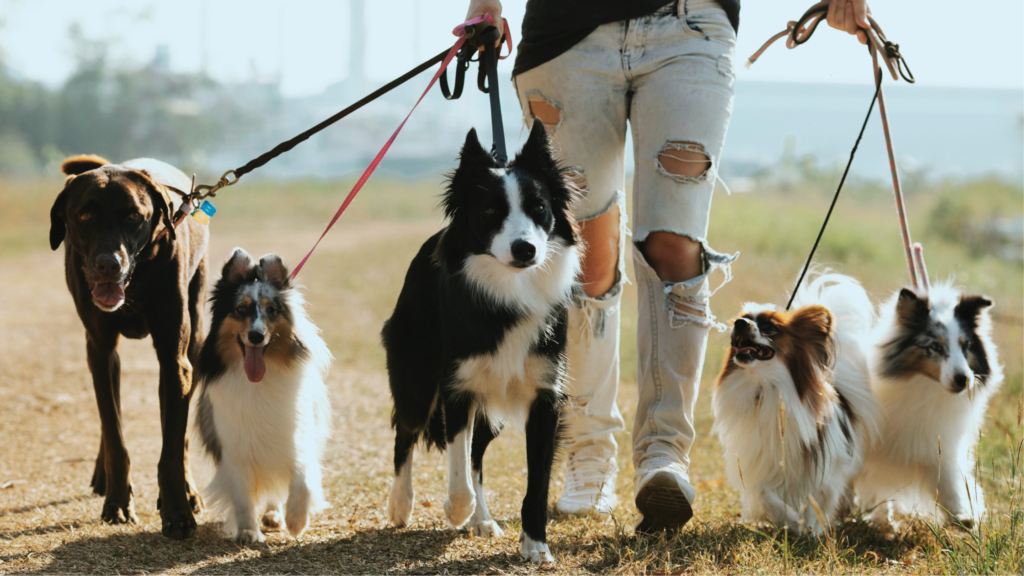Pack walks for dogs are group walks where multiple dogs and their owners walk together, often in a structured manner. This concept is based on the natural social structure of wolves, which are pack animals that roam together in groups. Domestic dogs, being descendants of wolves, still possess this instinct to walk and bond together.
Because you offer a secure and efficient means of exercising, training, and socializing dogs, pack walks are crucial for the health and welfare of dogs. They lessen the possibility that dogs will acquire problematic behaviors, help them behave better, and help them develop trust. Pack walks give dog owners an opportunity to strengthen their relationship to their pets, give them mental stimulation, and help socialize them.
Pack walks provide dogs of different sizes the chance to securely socialize with each other, learn from one another, and exercise good behavior in a controlled setting. Dogs can feel more at ease and a part of the group when they go on pack walks, that could improve their overall health.
Preparing for a Pack Walk
Preparing for going on a pack walk, it’s important to know which dogs are suitable. Take into account aspects like their size, age, personality traits, and wellness. Pack walks could not be an effective option for dogs that don’t get along with other dogs or have a history of aggressiveness.
Separate from health concerns, one of the most important vaccinations is to ensure that every one of your dogs got the current doses of rabies, distemper, adenovirus, parvovirus, parainfluenza, and leptospirosis. For dogs, routine flea and worm therapies are additionally advised.
Making the right equipment and gear choices entails picking a sturdy leash, a sturdy backpack or carrier for small dogs, and a comfortable and secure harness or collar. For dogs going on walks, it’s also advised to pack water and treats.
Organizing a Pack Walk
Choosing an area for a pack walk that is convenient, safe, and welcoming to both dogs and their owners is a crucial component of planning one. Take into account elements like accessibility, closeness to dog-friendly parks or trails, and the accessibility of facilities like water sources and rest areas.
The amount of dogs and owners taking the walk will determine the optimum pack size. Try to keep your group size reasonable to ensure it can be easily supervised and controlled. Usually, there are five to fifteen dogs and their owners in this.
Safe and enjoyable experience is ensured for all participants by defining guidelines and regulations. All of these might involve rabies shots, how long to wear a leash, and proper dog conduct. It is also important to communicate expectations for clean-up after dogs, respect for other dogs and owners, and adherence to local regulations and etiquette.
Conducting the Pack Walk
As a purpose of upholding order and guaranteeing the safety of all participating dogs, a calm and self-assured leader is essential during a pack walk. The dogs ought to be taught to behave themselves and respect by their leader, who should be able to offer guidance as well as structure.
Creating a pack hierarchy, clearly defining regulations and boundaries, and making sure all dogs have been socialized and trained appropriately are some methods for keeping the pack in order. Keeping an eye on how the dogs behave while out for a walk is additionally important, and any problems should be dealt with right away.
It’s critical to maintain composure and self-assurance when keeping an eye on and managing behavioral problems while out for a stroll. Behavior modification methods, like satisfying for good conduct and guiding dogs away from troublesome instances, can help reach this. For all dogs to feel safe and secure in the pack, it’s additionally critical to uphold consistency in behavior and the application of rules.
Ensuring Safety
While managing possible dog fights on a pack walk, it’s important to maintain composure and assertiveness. Aggression can be avoided, and tense situations can be eased by employing strategies like encouraging behavior, attention-redirecting, and, if needed, dog separation.
If taking a pack walk, it’s important to recognize signs of anxiety or stress in your canine companion. Among these symptoms are raised hackles, growling, trembling, and excessive panting. Each dog has body language that you should be aware of, so you should act upon any signs of anxiety.
Over a pack walk, it is essential to be ready for emergencies and take first aid precautions. Basic medical supplies and understanding, like bandages, antiseptic wipes, and a veterinarian’s contact details, ought to be possessed by dog owners. Being ready for unforeseen circumstances such as accidents or unexpected illnesses can help guarantee the security and health of every dog required.
Socialization and Training Opportunities
Fostering positive interactions among dogs during a pack walk is essential for socialization. This involves exposing dogs to new environments, people, and other dogs to build confidence and adaptability. Activities like visiting pet stores, hardware stores, or participating in structured pack walks can help dogs socialize effectively.
To identify proprietors as well as dogs alike, adding training exercises to the walk may render it more enjoyable. Training instructions like sit, stay, or heel while out for a walk, rewarding good behavior, and mentally stimulating the dogs are some of the exercises used in dog obedience training. This strengthens the bond between dogs and their owners and reinforces training in practical settings.
A mutually beneficial pack walk is largely dependent on providing reward for good behavior. In order to motivate dogs to repeat desired behaviors, positive reinforcement entails providing them with toys, treats, or praise. By using this technique, good conduct is reinforced, and an enjoyable connection is formed between obeying instructions and acting appropriately while out for a walk.
Pack Walks for Different Dog Breeds and Sizes
The unique requirements and traits of small, medium, and large breeds must be taken into account when designing pack walks for them. Larger breeds might require awhile of walks as well as greater exercise than smaller breeds, which might want shorter distances and slower steps. It is crucial to modify the walk to suit each of the breeds’ varying energy levels and physical capabilities.
Pack walks for various breeds require careful consideration of their energy levels and exercise requirements. Further mental and physical stimulation could be necessary for high-energy breeds, while calmer breeds might be happy with a comfortable walk. Every dog will benefit from the activity when the walk is customized according to their individual exercise needs.
Adapting the pace and distance for various breeds is essential to ensure that all dogs can participate comfortably. Some breeds may have limitations due to age, health issues, or physical condition, requiring a slower pace or shorter distance. By adjusting the walk to suit the needs of different breeds, owners can provide a positive experience for all dogs involved.
Community Building
Pack walks can be scheduled on occasion, such as the Sunday walks at Sidecut Metropark, giving dogs and their owners a regular chance to meet, greet, and bolster their relationships. People develop a feeling of every day and group as a result of this consistency.
By doing social media sites like Facebook and Instagram, where groups can be formed for interacting with other dog lovers in the neighborhood, it is possible to encourage local dog owners to participate in pack walks. A welcoming environment can be created for dogs and their owners through joining already-existing groups or forming new ones, which will improve the procedure of socialization.
Creating a supportive and social dog-owner community during pack walks involves promoting a positive and inclusive environment where all participants feel welcome. By following guidelines such as cleaning up after dogs, keeping walks safe in extreme weather conditions, bringing water for both dogs and owners, and supervising interactions between dogs, the community can ensure a safe and satisfying experience for everyone involved.
Challenges and Solutions
Managing typical obstacles on pack walks includes anticipating and managing dog disputes, identifying symptoms of anxiety or pain, and putting plans in place to keep the pack cohesive. Owners can make sure that all dogs involved have an enjoyable and secure time by being watchful, using positive reinforcement techniques, and stepping in quickly when necessary.
Providing solutions for leash reactivity and aggression during pack walks requires understanding the triggers that lead to these behaviors and implementing training techniques to address them. Techniques such as desensitization, counterconditioning, and using tools like head halters or harnesses can help manage leash reactivity and aggression effectively.
Utilizing a plan in place for emergencies, being ready with basic first aid supplies, knowing how to defuse conditions between dogs, and remaining composed and aggressive are some tips for handling unforeseen circumstances during pack walks. Owners can confidently handle unforeseen challenges and guarantee everyone’s safety by being prepared, perceptive, and sensitive to the needs of the dogs.
Conclusion
The development of social skills, confidence, and the bond between dogs and their owners are a few of the advantages of pack walks for dogs. Dogs can improve their social well-being and acquire important skills in collaboration, appropriate conduct, and dog interaction through pack walks. These walks provide owners the opportunity to have the enhancing experience of exploring new places with their pets, in addition to improving their relationship with them.
This fosters a sense of community among dog owners to support responsible dog ownership with group activities such as pack walks. Through these collective endeavors, owners may meet other local dog enthusiasts, acquire knowledge from expert trainers, and obtain insights into dog behavior and training. By offering possibilities for interacting with others, exercise, and education in a secure and supervised setting, this community involvement promotes ethical pet ownership.
By organizing pack walks, we can contribute to the development of a positive, encouraging, and welcoming dog community where both dogs and their owners can live happy, healthy lives. Participant preparedness for unforeseen circumstances, adherence to rules, and encouragement of positive interactions all help to foster harmonious relationships within the community. Dogs can safely socialize, explore the world, and create enduring relationships with each other while on pack walks, which also improve their physical and mental stimulation. All things considered, these walks are essential to fostering a thriving dog community that puts everyone’s happiness and health first.

